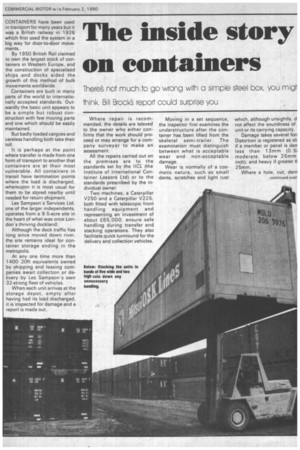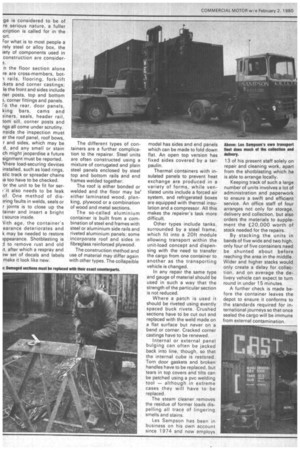The inside story on containers
Page 57

Page 58

If you've noticed an error in this article please click here to report it so we can fix it.
nereS not much to go wrong whn a simple steel box, you rnig ink. Bill Brock 's repol could surprise you
CONTAINERS have been used in transport for many years but it was a British railway in 1926 which first used the system in a big way for door-to-door movements.
By 1950 British Rail claimed to own the largest stock of containers in Western Europe, and the construction of specialised ships and docks aided the .growth of this method of bulk movements worldwide.
Containers are built in many parts of the world to internationally accepted standards. Outwardly the basic unit appears to be a simple but robust construction with few moving parts and one which should be easily maintained.
But badly loaded cargoes and careless handling both take their toll.
It is perhaps at the point where transfer is made from one form of transport to another that containers are at their most vulnerable. All containers in transit have termination points where the load is discharged, whereupon it is most usual for them to be stored nearby until needed for return shipment.
Les Sampson's Services Ltd, one of the larger independents, operates from a 9.5-acre site in the heart of what was once London's thriving dockland.
Although the dock traffic has long since moved down river, the site remains ideal for container storage ending in the metropolis.
At any one time more than 1400 20ft equivalents owned by shipping and leasing companies await collection or delivery by Les Sampson's own 32-strong fleet of vehicles.
When each unit arrives at the storage depot, empty after having had its load discharged, it is inspected for damage and a report is made out. Where repair is recommended, the details are telexed to the owner who either confirms that the work should proceed or may arrange for a company surveyor to make an assessment.
All the repairs carried out on the premises are to the standards set by the IICL (the Institute of International Container Lessors Ltd) or to the standards prescribed by the individual owner.
Two machines, a Caterpillar V250 and a Caterpillar V225, both fitted with telescopic front handling equipment and representing an investment of about £65,000, ensure safe handling during transfer and stacking operations. They also facilitate quick turnround for the delivery and collection vehicles. Moving in a set sequence, the inspector first examines the understructure after the container has been lifted from the skeletal semi-trailer. The examination must distinguish between what is acceptable wear and non-acceptable damage.
Wear is normally of a cosmetic nature, such as small dents, scratches and light rust which, although unsightly, d. not affect the soundness of unit or its carrying capacity.
Damage takes several fon Distortion is registered as sli if a member or panel is den less than 13mm (0.5i moderate, below 25mm inch); and heavy if greater tl 25mm.
Where a hole, cut, den1 go is considered to be of re serious nature, a fuller ;cription is called for in the on or what is to most people a rely steel or alloy box, the iety of components used in construction are considera.
o the floor section alone re are cross-members, bot-i rails, flooring, fork-lift :kets and corner castings; le the front and sides include nor posts, top and bottom 3, corner fittings and panels. ro the rear, door panels, king bars, cams and 3iners, seals, header rail, torn sill, corner posts and ngs all come under scrutiny. nside the inspection must er the roof panel, roof bows, r and sides, which may be d, and any smell or stain ch might jeopardise a future signment must be reported. 4/here load-securing devices installed, such as load rings, stic track or spreader chains ;e too have to be checked. or the unit to be fit for seri' it also needs to be leak of. One method of disaring faults in welds, seals or r joints is to close up the tamer and insert a bright t source inside.
Vith age, the container's earance deteriorates and k may be needed to restore ippearance. Shotblasting is j to remove rust and old it, after which a respray and aw set of decals and labels make it look like new. The different types of containers are a further complication to the repairer. Steel units are often constructed using a mixture of corrugated and plain steel panels enclosed by steel top and bottom rails and end frames welded together.
The roof is either bonded or welded and the floor may be' either laminated wood, planking, plywood or a combination of wood and metal sections.
The so-called aluminium container is built from a combination of steel end frames with steel or aluminium side rails and riveted aluminium panels; some incorporate roof and sides in fibreglass reinforced plywood.
The construction method and use of material may differ again with other types. The collapsible
model has sides and end panels which can be made to fold down flat. An open top version has fixed sides covered by a tarpaulin.
Thermal containers with insulated panels to prevent heat exchange are produced in a variety of forms, while ventilated units include a forced air system, and refrigerated boxes are equipped with thermal insulation and a compressor. All this makes the repairer's task more difficult.
Other types include tanks, surrounded by a steel frame, which fit into a 20ft module allowing transport within the unit-load concept and dispensing with the need to transfer the cargo from one container to another as the transporting vehicle is changed.
In any repair the same type and gauge of material should be used in such a way that the strength of the particular section is not reduced.
Where a patch is used it should be riveted using evently spaced buck rivets. Crushed sections have td be cut out and replaced with the weld made on a flat surface but never on a bend or corner. Cracked corner castings have to be renewed.
Internal or external panel bulging can often be jacked back into line, though, so that the internal cube is restored. Torn door gaskets and broken handles have to be replaced, but tears in top covers and tilts can be patched using a pvc welding tool — although in extreme cases they will have to be replaced.
The steam cleaner removes the residue of former loads dispelling all trace of lingering smells and stains.
Les Sampson has been in business on his own account since 1 974 and now employs Above: Les Sampson's own transport fleet does much ot the collection and delivery.
13 of his present staff solely on repair and cleaning work, apart from the shotblasting which he is able to arrange locally.
Keeping track of such a large number of units involves a lot of administration and paperwork to ensure a swift and efficient service. An office staff of four arranges not only for storage, delivery and collection, but also orders the materials to supplement the £20,000 worth of stock needed for the repairs.
By stacking the units in bands of five wide and two high, only four of five containers need be shunted about before reaching the area in the middle. Wider and higher stacks would only create a delay for collection, and on average the delivery vehicle can expect to turn round in under 15 minutes.
A further check is made before the container leaves the depot to ensure it conforms to the standards required for international journeys so that once sealed the cargo will be immune from external contamination.








































































































































